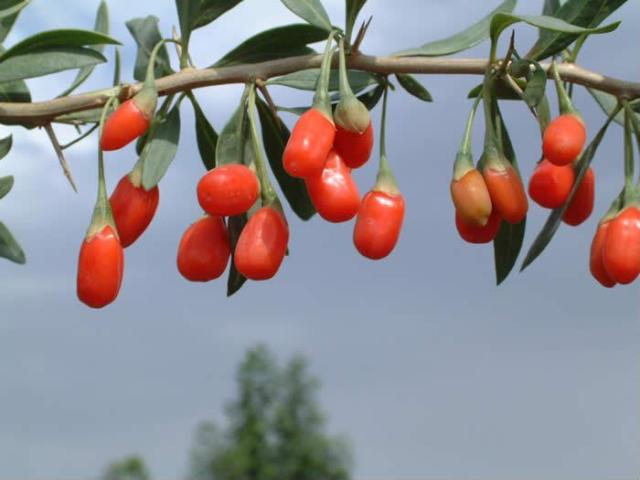Goji Berries: Origins - Consumption - Nutrition Facts - Health Benefits
|
|
|
Contents
- Geographic origin and regions grown
- History of consumption
- Common consumption today
- Nutrition Facts: Vitamins, minerals and phytochemical components
- Health Benefits: Medicinal uses based on scientific studies
- Bibliography
Geographic Origins and Regions Grown

The original habitat of the goji plant, often referred to as the wolfberry, is to date unknown. The region of origin is proposed to be somewhere in the southeastern parts of Europe or the southwestern region of Asia. Currently, China is responsible for the majority of commercially grown goji on plantations near the Yellow River floodplains. However, it is typically grown in most parts of the world.
It is a species of two boxthorn varieties in the Solanaceae family, better known as the nightshade family. This family of wolfberries is related to eggplants, potatoes, tomatoes, peppers, flowers, tobacco, and of course the deadly nightshade.
The wolfberry grows to a height of approximately 3 to 10 feet. Southern Chinese varieties of the wolfberry tree are shorter than their northern counterparts. Flowers are one to three on a stem and start out as bell-shaped before bursting to accommodate and release the growing berry. The striking orange-red “pepper-shaped” berry is a half-inch to an inch in size.
History of Consumption
Common names for the goji berry include: Chinese wolfberry, Tibetan or Himalayan goji, barbary matrimony vine, bocksdorn, Duke of Argyll’s tea tree, cambronera vine, and matrimony vine. The berries are processed with care to prevent spoiling from harvesting damage.
The most common form of consumable wolfberries is the dried form. The texture varies from that of a prune or chewy raisin to a harder, gummy consistency that is similar to a dried Chinese mushroom. Once dried, the wolfberry is not usually re-hydrated. Instead they are are used in their dried state as a sweet snack or for medicinal purposes.
For a few thousand years, wolfberries have been an important part of Chinese medicine and that of other Asian traditions as well. Traditional Chinese cuisine feature wolfberries in rice congee or with other vegetables in restorative soups and mixed with various flowers to create herbal teas.
Common Consumption Today

The wolfberry is growing in popularity due to its health benefits. During the past few years, the wolfberry has been included in many new products throughout the world. Its most popular form of consumption now-a-days is as a dried fruit snack added to granola bars or eaten alone.
It is a welcomed addition to many beverages including herbal teas, instant coffee, wine, and more recently different types of beer. In addition to the berries, the shoots and leaves from young wolfberry plants can also be eaten.
Common exports of wolfberries range from dried berries and berry juice to powders made from the pulp and juice. Marketing of the wolfberry is spreading in the west and touts the health benefits of the goji berry.
Nutrition Facts: Vitamins, Minerals and Phytochemical Components
The wolfberry contains levels of vitamin C that can only be rivaled by citrus fruits and strawberries in addition to riboflavin (vitamin B2), calcium, potassium, iron, zinc, and selenium. It is full of carbohydrates, protein, fat, and dietary fiber as well as numerous phytochemicals and nutrients (5). Phytochemicals such as beta-carotene, zeaxanthin, and polysaccharides can be found in the wolfberry (1), (2).
Some of the content of the phytochemicals vary between production regions, thereby creating discrepancies in many studies of the goji plant. This points leads to the difficulty faced in measuring the health benefits of the goji plant. However, the only real dilemma that scientists are currently facing with the goji plant is whether it is healthy or extremely healthy.

Health Benefits: Medicinal Uses Based on Scientific Studies
A long list of medicinal uses for the wolfberry has found its way into traditional Chinese medicine (2). Once consumed, it will enhance the immune system, protect the liver, improve eyesight and circulation, and increase sperm production just to name a few of its beneficial properties. The leaves have been used to treat inflammatory and other skin diseases, while the root bark is used to aid in the fight against human pathogenic bacteria and fungi (3), (4).
The polysaccharides contained within the wolfberry act as dietary fiber and aid the maintenance of a healthy colon. Zeaxanthin, a dietary carotenoid, acts as an antioxidant in addition to providing protective light-filtering properties as it is absorbed by the retinal macula lutea (1). Essentially this factor lowers the risk of age-related macular degeneration and glaucoma.
Bibliography
1. Benzie, I.F., Chung, W.Y., Wang, J., Richelle. M,, Bucheli, P., (2006). Enhanced bioavailability of zeaxanthin in a milk-based formulation of Wolfberry (Gou Qi Zi; Fructus barbarum L.). Br J Nutr. 96(1):154-60
2. Gross, P.M., Zhang, X., Zhang, R. (2006). Wolfberry phytochemicals and disease research: implied health benefits, chapter 6 and Wolfberries and Traditional Chinese Medicine, chapter 7. Wolfberry: Nature’s Bounty of Nutrition and Health. Booksurge Publishing, Charleston, SC, USA.
3. Lee, D.G., Jung, H.J., Woo, E.R. (2005). Antimicrobial property of (+)-lyoniresinol-3alpha-O-beta-D-glucopyranoside isolated from the rood bark of Lycium chinense Miller against human pathogenic microorganisms. Arch Pharm Res. 28 (9): 1031-6.
4. Lee, D.G., Park, Y., Kim, M.R., Jung, H.J., Seu, Y.B., Hahm, K.S., Woo, E.R. (2004). Anti-fungal effects of phenolic amides isolated from the root bark of Lycium chinense. Int. Biotechnol Lett. 26(14): 1125-30.
5. Roy, C.C., Kien, C.L., Bouthillier, L., Levy, E. (2006). Short-chain fatty acids: ready for prime time? Nutr Clin Pract. 21 (4): 351-66.
Disclaimer
Nutritiousfruit.com provides this website as a service. Although the information contained within the website is periodically updated, no guarantee is given that the information provided is correct, complete, and/or up-to-date. The materials contained on this website are provided for general information purposes only and do not constitute legal or other professional advice on any subject matter. Nutrtiousfruit.com does not accept any responsibility for any loss, which may arise from reliance on information contained on this website. The information and references in this website are intended solely for the general information for the reader. The content of this website are not intended to offer personal medical advice, diagnose health problems or to be used for treatment purposes. It is not a substitute for medical care provided by a licensed and qualified health professional. Please consult your health care provider for any advice on medications.
Didn't find what you were looking for? Search here...

Amazon Search Box:
Did you like this page?
|
|
|




